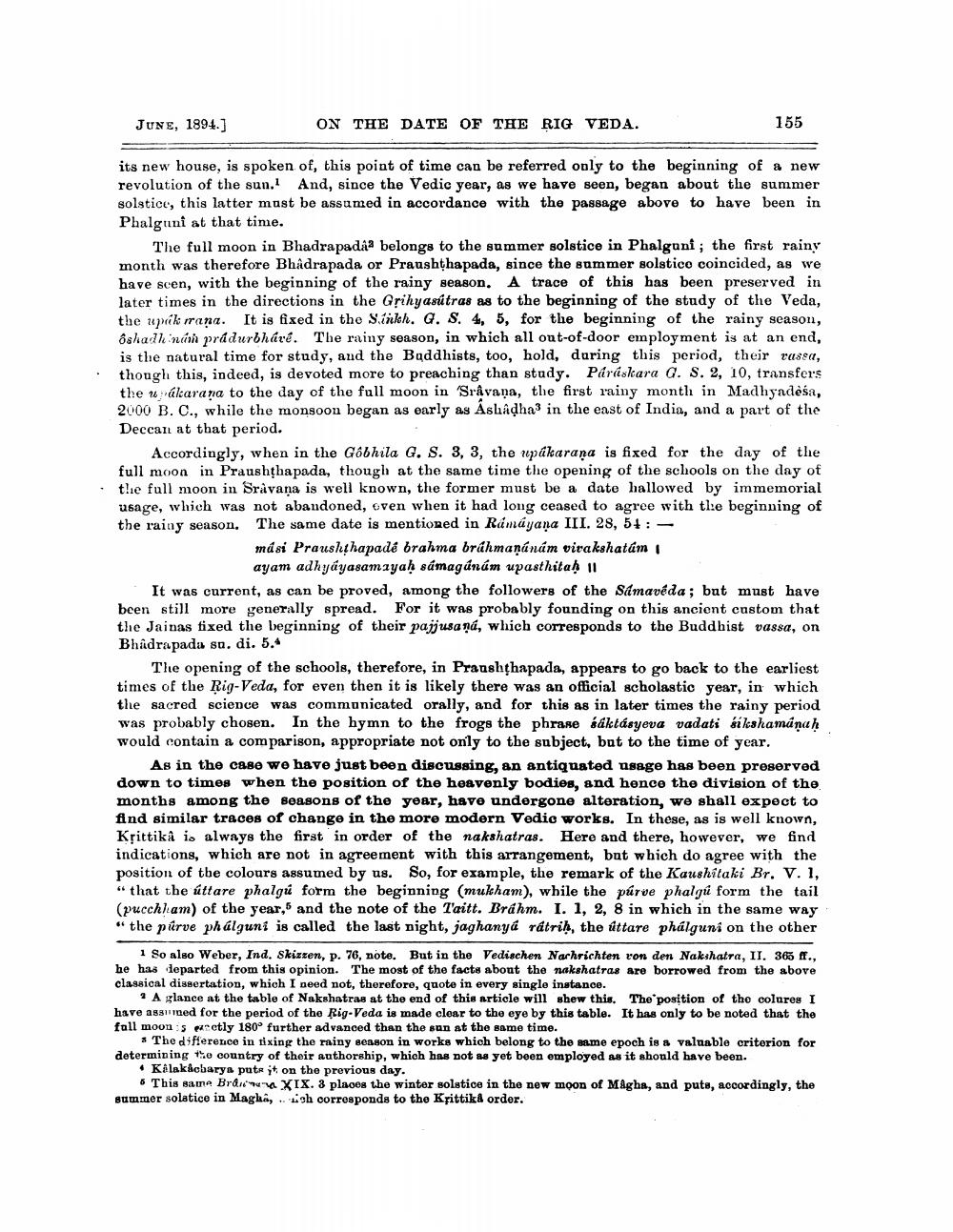________________
JUNE, 1894.]
ON THE DATE OF THE RIG VEDA.
155
its new house, is spoken of, this point of time can be referred only to the beginning of a new revolution of the sun. And, since the Vedic year, as we have seen, began about the summer solstice, this latter must be assumed in accordance with the passage above to have been in Phalguni at that time.
The full moon in Bhadrapadaa belongs to the summer solstice in Phalguni; the first rainy month was therefore Bhadrapada or Praushthapada, since the summer solstico coincided, as we have scen, with the beginning of the rainy season. A trace of this has been preserved in later times in the directions in the Grihyasútras as to the beginning of the study of the Veda, the uprik rana. It is fixed in the Sinkh. G. S. 4, 5, for the beginning of the rainy season, ôshadhinn prádurbháré. The rainy season, in which all out-of-door employment is at an end, is the natural time for study, and the Baddhists, too, hold, during this period, their rusea, though this, indeed, is devoted more to preaching than study. Páráskara a. S. 2, 10, transfers the wákarana to the day of the full moon in Sravana, the first rainy month in Madhyadeśa, 2000 B. C., while the monsoon began as early as Ashadha3 in the east of India, and a part of the Deccan at that period.
Accordingly, when in the Gobhila G. S. 3, 3, the upákarana is fixed for the day of the full moon in Praushthapada, though at the same time the opening of the schools on the day of the full moon in Sravana is well known, the former must be a date hallowed by immemorial usage, which was not abandoned, even when it had long ceased to agree with tl:e beginning of the rainy season. The same date is mentioned in Ramayana III. 28, 5+:
mási Praushthapadé brahma brühmaņánám virakshatam
ayam adhyayasamayah samagánúm upasthitah 11 It was current, as can be proved, among the followers of the Sámavéda; bat must have been still more generally spread. For it was probably founding on this ancient custom that the Jainas fixed the beginning of their pajjusand, which corresponds to the Buddhist vassa, on Bhadrapada sn, di. 5.4
The opening of the schools, therefore, in Praushthapada, appears to go back to the earliest times of the Rig Veda, for even then it is likely there was an official scholastic year, in which the sacred science was communicated orally, and for this as in later times the rainy period was probably chosen. In the hymn to the frogs the phrase baktásyeva vadati ákshamanah would contain a comparison, appropriate not only to the subject, but to the time of year.
As in the case we have just been discussing, an antiquated usage has been preserved down to times when the position of the heavenly bodies, and hence the division of the months among the seasons of the year, have undergone alteration, we shall expect to find similar traces of change in the more modern Vedic works. In these, as is well known, Ksittika is always the first in order of the nakshatras. Here and there, however, we find indications, which are not in agreement with this arrangement, but which do agree with the position of the colours assumed by us. So, for example, the remark of the Kaushitaki Br. V. 1, " that the úttare phalgú form the beginning (mukham), while the púrve phalgú form the tail (pucchiam) of the year, and the note of the Taitt. Bráhm. I. 1, 2, 8 in which in the same way " the pirve phálguni is called the last night, jaghanyá rátrih, the attare phálguni on the other
1 So also Weber, Ind. Skizzen, p. 76, note. But in the Vedischen Nachrichten von den Nakshatra, II. 365 ff., he has departed from this opinion. The most of the facts about the nakshatras are borrowed from the above classical dissertation, which I need not, therefore, quote in every single instance.
? A glance at the table of Nakshatras at the end of this article will shew this. The position of the colures I have assumed for the period of the Rig Veda is made clear to the eye by this table. It has only to be noted that the full moon 5 eretly 180o further advanced than the sun at the same time.
* The difference in tixing the rainy season in works which belong to the ame epoch is a valuable criterion for determining the country of their authorship, which has not as yet been employed as it should have been.
• Kilakaobarya puts it on the previous day.
6 This same Bralina XIX. 3 places the winter solstice in the new moon of Mighs, and puts, accordingly, the suminer solstice in Magka, tish corresponds to the Krittiki order.




